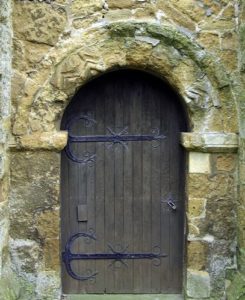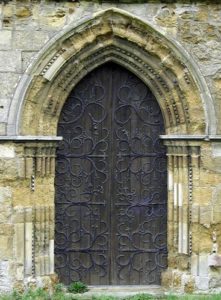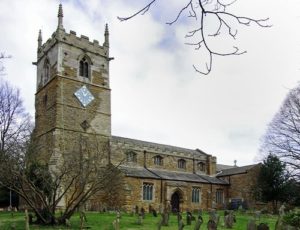The church is in a lovely setting surrounded by trees in the ancient graveyard to the west of the market place. There were snowdrops, winter aconites and crocuses in flower in February and the constant sound of birdsong.
There has been a church here since the 7thC. The massive west tower with its buttresses and Norman doorway is the oldest part of the church. The top of the tower with its huge gargoyles, battlements and tall pinnacles was added in the 15thC. An old sundial can be seen below the clock on the south side. The nave with its beautiful south doorway with carved arches with nail head carving and splendid iron hinges is 13thC, replacing an earlier Norman nave. The clerestory and side aisles were added in the 14thC and the chancel was rebuilt in the 19thC.
The church is open daily and entry is through the north door, where a notice warns the unwary of three steps down into the church. It feels a big church with octagonal pillars and pointed arches separating nave and side aisles. At the base of the arches on the south side are small carved heads. On the north wall are what are described as ‘nail head’ decorations which look a bit like the swirls of walnutless whips.
The font is at the west end, with a church bell on the floor beside it and the children’s corner at the back of the north aisle.
Our eyes were drawn to the painted rood beam across the pointed chancel arch. This dates from the 1920s and has a crucifix with a pelican pecking her breast to feed her young beneath. On either side are the figures of the Virgin MAry and t John. Outside these are angles holding tall candles.
In front of the chancel arch is a wooden lectern with carved figures of St Peter and St Paul underneath and the pulpit which has a glass case in front with the 1899 Caistor Bible.
On the north wall set in an arched recess is the tomb of Sir William de Hundon , a 13thC crusader knight in chain mail and surcoat. It is thought he may have been responsible for building the north aisle with a chantry chapel at the east end. This is now the Lady Chapel with a small altar with a wooden reredos. This has painted panels of the Virgin Mary and Christ Child with angels.
Next to Sir William is a glass case containing the gad whip. This has a long wooden pole (the stock) with a long lash. It was used by ploughmen to goad the oxen to work faster and harder. A board explains the tradition of the gad whip which was unique to Caistor. Every Palm Sunday, the Lord of the Manor had to provide a gad whip and man to take to the church during Matins. Attached to the upper end of the stock was a purse containing 30 coins. During the reading of the first lesson, the man cracked the whip three times in the north porch. He then walked into the church and waved the whip three times over the head of the clergyman as he read the second lesson and held the whip there until the end of the reading. The whip was then placed in the pew of the Lord of the Manor.
In 1836 there was a petition to Parliament asking to have the ceremony outlawed as an “indecent and absurd practice”. This in fact had the opposite effect as more people came to watch. The tradition ended in 1846 when the Lord of the Manor changed hands.
Near the gad whip is a second glass case containing a piece of stone which is allegedly from the Holy land and consists of mortar mixed with blood and bones.
in the Lady Chapel set under a cusped recess is the tomb of Sir John de Hundon, who was Sheriff of Lincolnshire in 1343, again wearing armour.
The chancel was rebuilt in the 19thC but retains three lancet windows at the east end. It has a simple altar. On the south wall is the organ in what was originally the Maddison Choir. The wooden wall panelling commemorates the dead of both World Wars.
The windows in the church contain 19thC stained glass. The painted roof or the nave and chancel are also 19thC. The nave has painted panels with symbols of the Passion.
Before leaving, spend a few minutes admiring the beautiful embroidered kneelers which record Caistor life.










